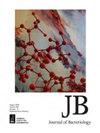A flow equilibrium of zinc in cells of Cupriavidus metallidurans.
IF 2.7
3区 生物学
Q3 MICROBIOLOGY
引用次数: 0
Abstract
The hypothesis was tested that a kinetical flow equilibrium of uptake and efflux reactions is responsible for balancing the cellular zinc content. The experiments were done with the metal-resistant bacterium Cupriavidus metallidurans. In pulse-chase experiments, the cells were loaded with radioactive 65Zn and chased with the 100-fold concentration of non-radioactive zinc chloride. In parallel, the cells were loaded with isotope-enriched stable 67Zn and chased with non-enriched zinc to differentiate between zinc pools in the cell. The experiments demonstrated the existence of a kinetical flow equilibrium, resulting in a constant turnover of cell-bound zinc ions. The absence of the metal-binding cytoplasmic components, polyphosphate and glutathione, metal uptake, and metal efflux systems influenced the flow equilibrium. The experiments also revealed that not all zinc uptake and efflux systems are known in C. metallidurans. Cultivation of the cells under zinc-replete, zinc-, and zinc-magnesium-starvation conditions influenced zinc import and export rates. Here, magnesium starvation had a stronger influence compared to zinc starvation. Other metal cations, especially cobalt, affected the cellular zinc pools and zinc export during the chase reaction. In summary, the experiments with 65Zn and 67Zn demonstrated a constant turnover of cell-bound zinc. This indicated that simultaneously occurring import and export reactions in combination with cytoplasmic metal-binding components resulted in a kinetical flow equilibrium that was responsible for the adjustment of the cellular zinc content. IMPORTANCE Understanding the biochemical action of a single enzyme or transport protein is the pre-requisite to obtain insight into its cellular function but this is only one half of the coin. The other side concerns the question of how central metabolic functions of a cell emerge from the interplay of different proteins and other macromolecules. This paper demonstrates that a flow equilibrium of zinc uptake and efflux reactions is at the core of cellular zinc homeostasis and identifies the most important contributors to this flow equilibrium: the uptake and efflux systems and metal-binding components of the cytoplasm.金属铜绿菌细胞中锌的流动平衡。
实验验证了一个假设,即吸收和流出反应的动力学流动平衡是平衡细胞锌含量的原因。实验是在抗金属细菌金属杯状芽孢杆菌(Cupriavidus metallidurans)中进行的。在脉冲追逐实验中,细胞装入放射性 65Zn,并用 100 倍浓度的非放射性氯化锌进行追逐。同时,在细胞中装入同位素富集的稳定 67Zn,并用非富集锌进行追逐,以区分细胞中的锌池。实验证明,细胞内存在一种动力学流动平衡,导致细胞结合的锌离子不断周转。细胞质中金属结合成分、多聚磷酸盐和谷胱甘肽、金属吸收和金属外流系统的缺失都会影响流动平衡。实验还发现,在金龟子中并非所有的锌吸收和外排系统都是已知的。在锌充足、锌饥饿和锌镁饥饿条件下培养细胞会影响锌的输入和输出率。与锌饥饿相比,镁饥饿的影响更大。在追逐反应过程中,其他金属阳离子,尤其是钴,会影响细胞锌池和锌的输出。总之,用 65Zn 和 67Zn 进行的实验表明,细胞结合的锌在不断周转。重要意义 了解单个酶或转运蛋白的生化作用是深入了解其细胞功能的先决条件,但这只是问题的一半。另一面涉及细胞的中心代谢功能如何从不同蛋白质和其他大分子的相互作用中产生的问题。本文论证了锌摄取和流出反应的流动平衡是细胞锌平衡的核心,并确定了这种流动平衡最重要的促成因素:细胞质中的摄取和流出系统以及金属结合成分。
本文章由计算机程序翻译,如有差异,请以英文原文为准。
求助全文
约1分钟内获得全文
求助全文
来源期刊

Journal of Bacteriology
生物-微生物学
CiteScore
6.10
自引率
9.40%
发文量
324
审稿时长
1.3 months
期刊介绍:
The Journal of Bacteriology (JB) publishes research articles that probe fundamental processes in bacteria, archaea and their viruses, and the molecular mechanisms by which they interact with each other and with their hosts and their environments.
 求助内容:
求助内容: 应助结果提醒方式:
应助结果提醒方式:


